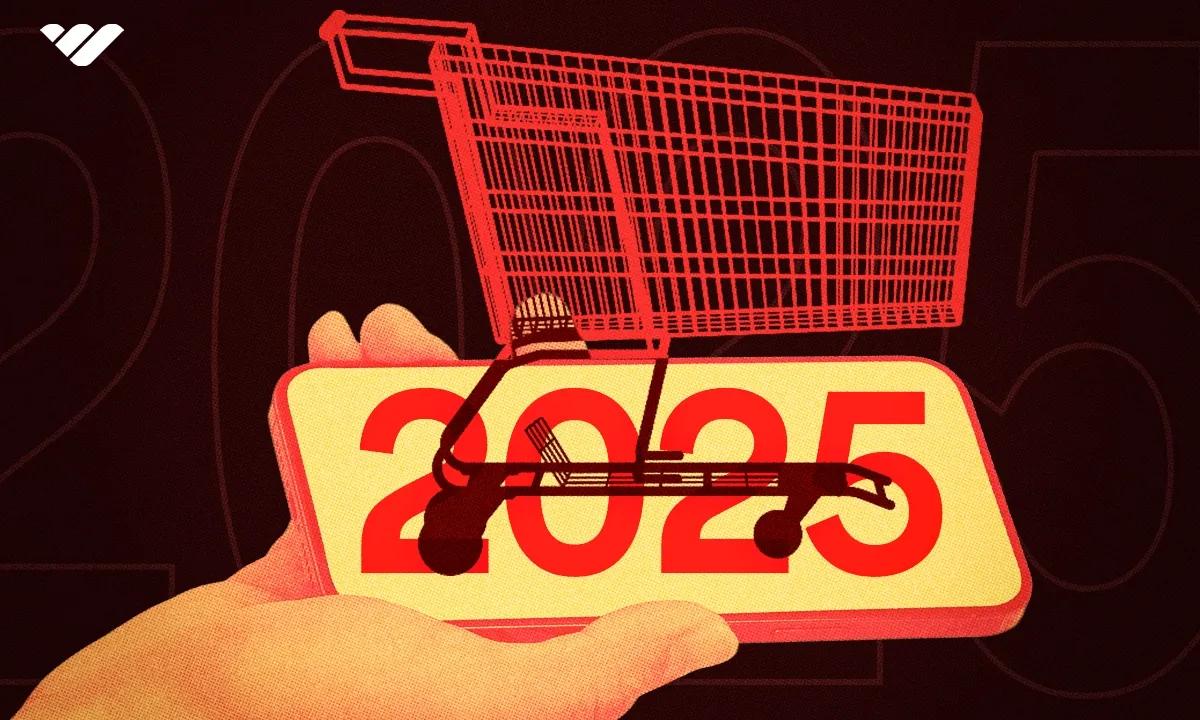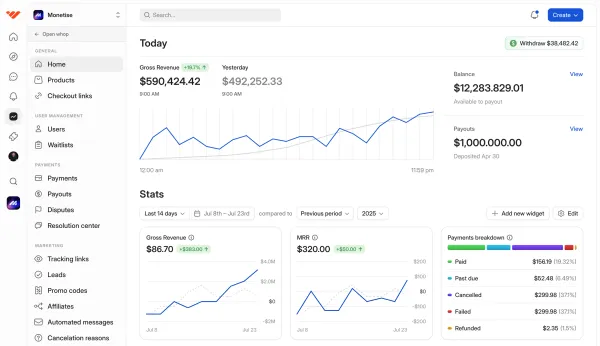Discover essential ecommerce trends to stay ahead in the online marketplace. Understand the latest strategies, consumer behaviors, and technological advancements shaping the industry.
Key takeaways
- Ecommerce revenue is expected to reach $7 trillion with 25% of total global sales by 2027.
- AI chatbots operate 24/7 and learn customer preferences through machine learning for personalized service.
- Social commerce is projected to reach $8.5 trillion by 2030 across platforms like Instagram and TikTok.
- 91% of online shoppers prefer making purchases using their smartphones according to Forbes Advisor.
- Cart abandonment occurs in 48% of cases due to extra shipping, tax, and fee costs.
Whether it’s selling products, providing services, or even creating content such as product reviews, ecommerce has opened many doors for entrepreneurs of all types to make money online.
And if you have an online business or are someone studying the best way to work in ecommerce, you need to know that, as in any market, being up to date with the main trends of the moment is the secret to being successful in the arena.
In this guide, we’ll explain the importance of keeping up with what’s popular in terms of ecommerce strategies and tools for an online business, present some interesting facts and statistics, and show you the main ecommerce trends in 2026. Ready to get up to date? Then keep reading and find out.
Why is it important to keep up with ecommerce trends?
With technology and customer behaviors changing and evolving on an almost daily basis, staying informed about any industry shifts is essential because it allows companies to adapt quickly, develop new strategies, incorporate new tools and software in their operations to keep providing good customer services, and maintain a competitive edge.
Customer service is one of the key points of following ecommerce trends. With the practicalities of the internet, online shoppers have developed high expectations for convenience, personalization, and speed when they’re browsing for products and services.
This is the reason, for instance, the implementation of AI chatbots for customer service is trending in ecommerce. These softwares provide automated solutions that make the shopping experience fast, efficient, and tailored to each user.
Trends can also indicate changes in customer values and behavior. One good example is the growing focus on sustainability and ethical practices. Today, many online shoppers prefer eco-friendly products and tend to become more loyal to brands that align with their values.
Keeping up with ecommerce trends is not just beneficial for your online business, but necessary. It enables you to enhance customer service, align with your audience's values and needs, and stay competitive in an ever-evolving industry. By identifying and adopting these trends, your business can connect with your audience on a deeper level, enhancing your brand’s reputation, appeal, and profitability.
Ecommerce facts and statistics
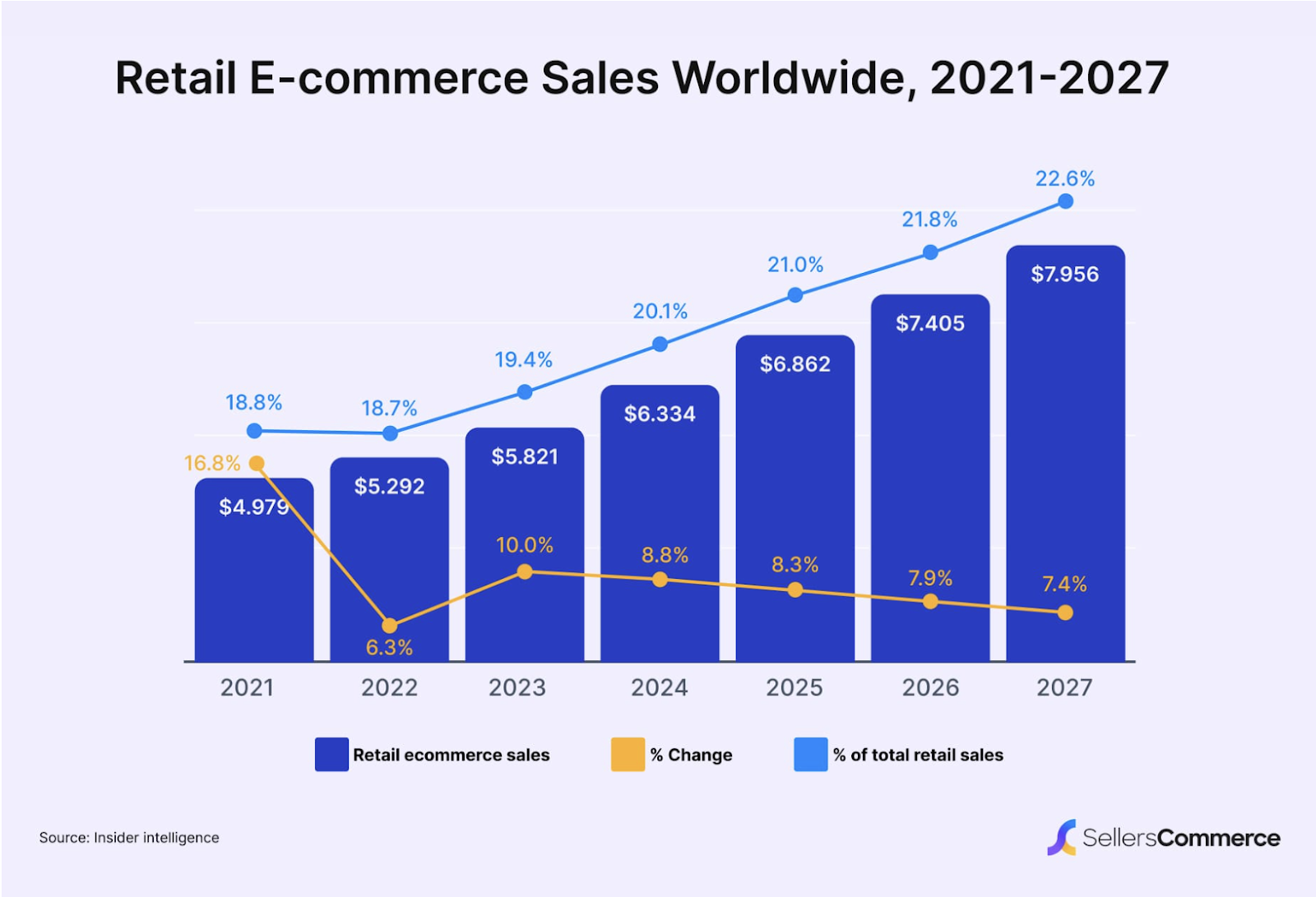
Let’s take a look at some interesting and useful facts and statistics about ecommerce in 2026 and beyond.
Overall market size and growth
- Purchase growth: By 2027, 23% of retail purchases are expected to take place online—according to Forbes.
- Increase in revenue: Ecommerce revenue is expected to be $7 trillion with a 25% share of total global sales—according to Minksey & Company
- Industry expansion: Ecommerce as a whole is expected to grow at a significant rate in the coming years, exceeding $17 trillion in 2032
- Ecommerce leaders: Amazon, eBay, and AliExpress are the most visited ecommerce websites in the world. Not counting the number of sales, Amazon takes first place with AliExpress in second.
Consumer behavior
- Online shoppers: 2.77 billion people are projected to shop online in 2025, according to Doofinder.
- Shopper’s preference: Forbes points out that 52% of online shoppers report shopping internationally. Many reasons include better pricing and availability of specific products.
- Cart abandonment: Extra costs with shipping, taxes, and fees are the main reason for cart abandonment in 48% of the cases—according to Statista
- Shipping problems: Forbes Advisor also reveals that 24% drop out of an online shopping session because shipping is too slow, signaling the preference for faster shipping (more on this below).
Social media commerce
- Social commerce sales: According to Statista, social media commerce is expected to reach $8.5 trillion by 2030, showing the preference for social media as a sales channel, especially by influencers and their followers.
- Leading platform: Facebook is the most popular social media platform for social commerce transactions. While Facebook Shop is a great feature for online businesses, Facebook Marketplace offers a good option for local “face-to-face” sellers, making Facebook an all-around good option for ecommerce.
- Influencer marketing: 49% of social commerce shoppers have had an influencer’s recommendation impact their purchase. This shows how powerful influencer marketing can be on conversion rates for your business.
Ecommerce trends in 2026
Here are the top ecommerce trends to be expected in 2026:
AI chatbots and machine learning for customer service

AI Chatbots are already a very present tool on several ecommerce platforms, helping companies at various points in a user's purchasing journey, whether it be answering questions about products and services offered, making purchase suggestions, and even updating users with shipping, giving the status and precise location of their purchase.
It’s a trend that’s here to stay and will only improve with machine learning and natural language processing (NLP), learning each customer’s individual preferences to provide personalized and more efficient service.
The best thing about AI chatbots for customer service is that they can operate 24/7 and in multiple languages, helping your company reach a global audience without the extra expense of large teams.
AI-generated ads

Creating tailored advertisements based on user data, preferences, and browsing history of users, ads generated by artificial intelligence is a trend that initially faced resistance. But has been growing in ecommerce due to the fact that consumers simply respond better to personalized ads rather than generic messages.
This personalized approach allows your business to target customers more effectively, increasing click-through and conversion rates. Machine learning can even predict the types of ads most likely to resonate with specific audience segments, optimizing ads to match individual interests and making marketing campaigns more efficient. This trend is all about adapting a tool to increase the effectiveness of a marketing team.
Social commerce

In recent years, platforms like Instagram, TikTok, and Facebook have been integrating more and more shopping features, such as shoppable posts and in-app checkouts, making these websites great sales channels for companies. So much so that it’s not uncommon for some businesses to base their operations solely on a single social media platform instead of investing in websites or on a storefront in marketplaces like Amazon or Etsy.
This direct connection between social media and shopping makes it easy for customers to discover products in a more interactive and personalized way. It’s a trend adopted by both large and small companies, as it can be very beneficial for driving sales and building a stronger community of engaged customers around your brand.
Commerce content
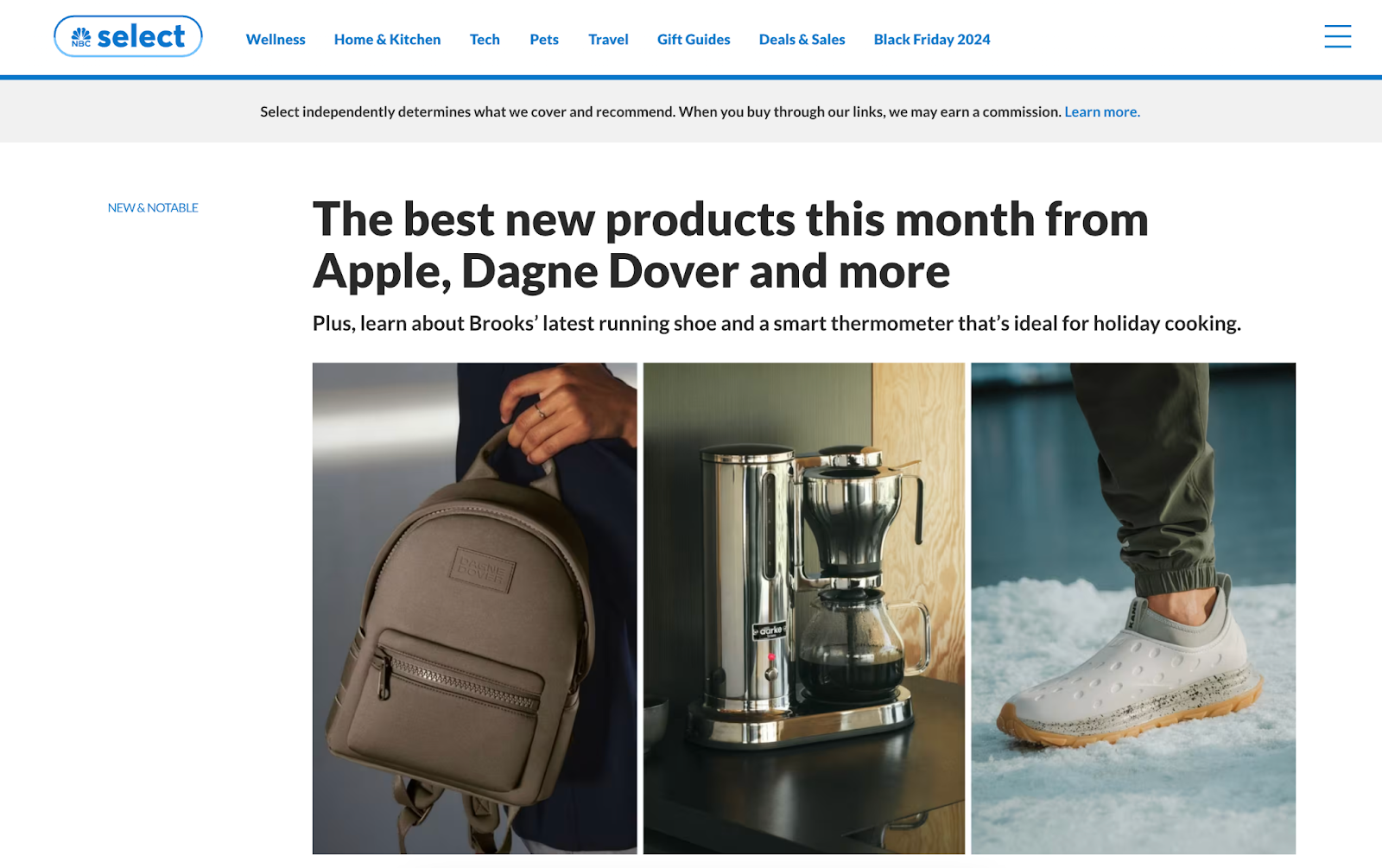
Commerce content is a marketing strategy that, unlike traditional ads, is a more educational and value-driven form of media, such as blog posts, video tutorials, and how-to guides that provide customers with product information, usage tips, and purchasing advice.
This trend aligns well with modern consumers’ preference for self-guided shopping, where they can research the products they’re interested in before committing to a purchase. High-quality commerce content with good SEO also improves search engine rankings and drives organic traffic, positioning brands as trustworthy sources in their industry and supporting long-term customer loyalty.
Influencer marketing
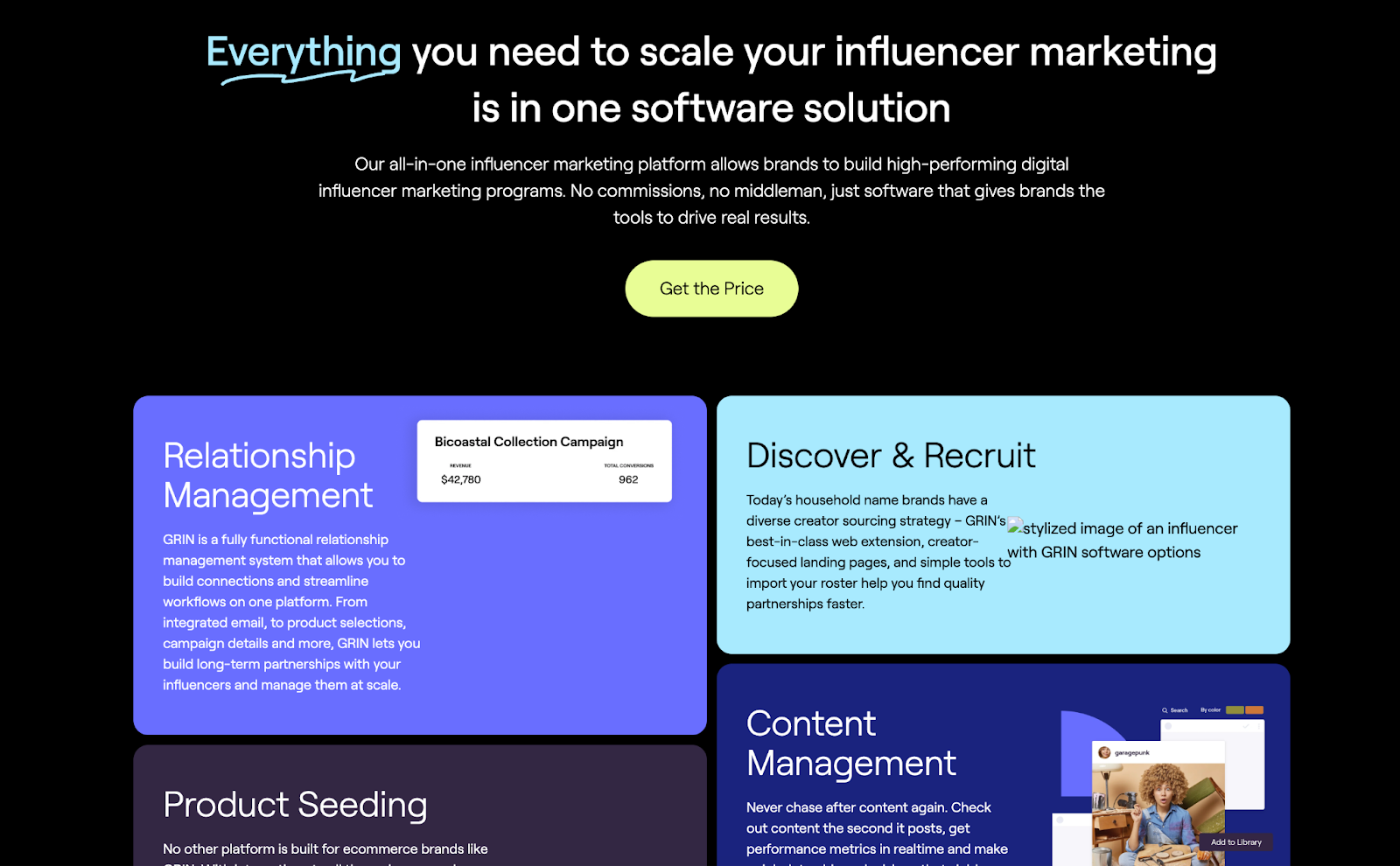
Many ecommerce companies are forming long-term partnerships with influencers, especially in niche markets, to build consistent brand awareness and credibility. Influencer marketing is a trend that revolves around brands leveraging influencers’ loyal followings to drive word-of-mouth advertising and product recommendations.
If your company is focused on selling health-related products, for example, partnering with a fitness influencer is an excellent choice as they will present your products to an audience that’s already interested in this type of product, using social proof to increase engagement around your brand and, eventually, making high profits.
Voice-search shopping
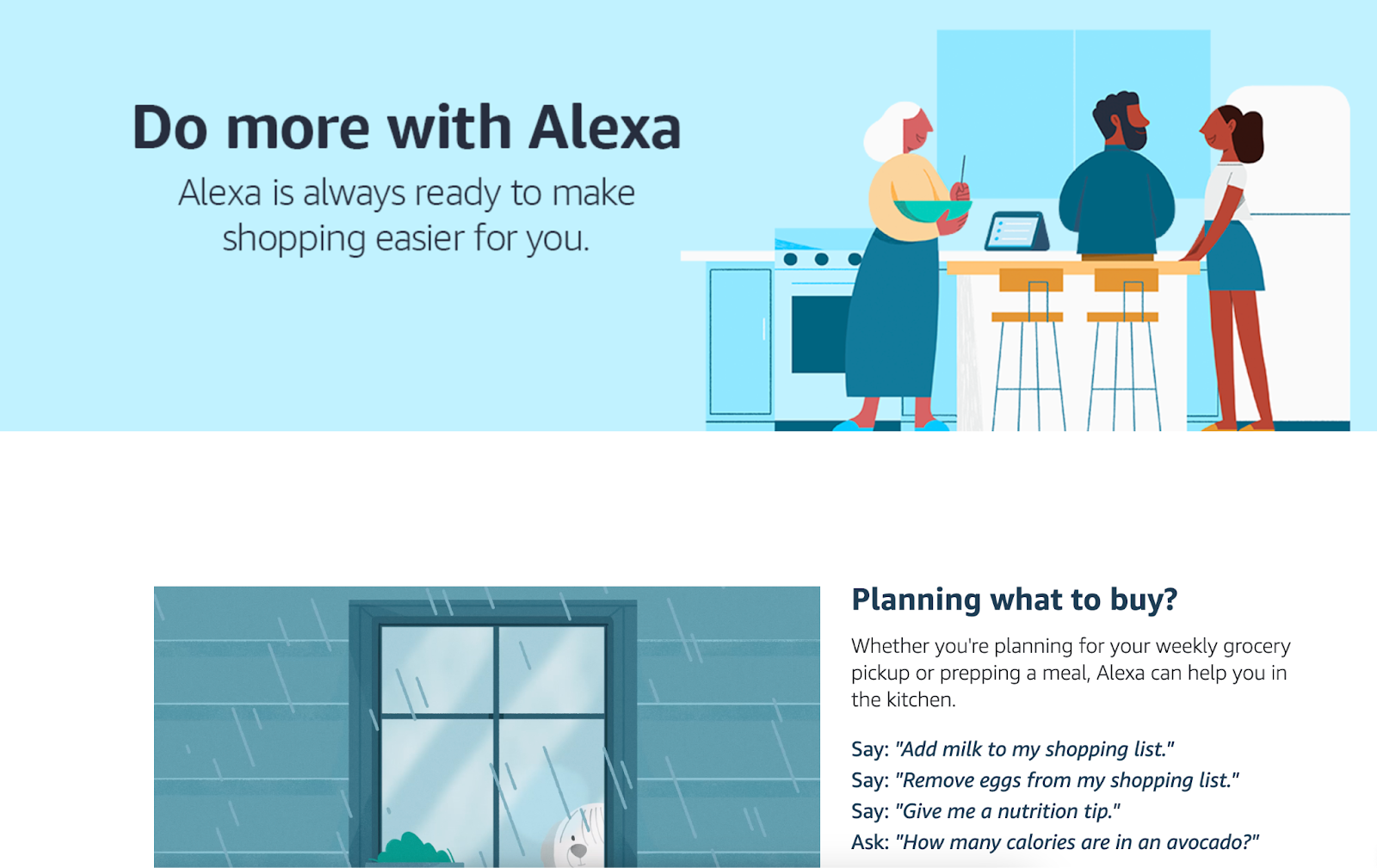
As more people opt for technology in their households, smart speakers like Amazon’s Alexa, Google Assistant, and Siri are becoming very common. And with that, voice-search shopping is gaining popularity around the world.
This practical form of shopping, using voice commands to search for products, check availability, and even place orders, is a trend that requires ecommerce platforms to optimize for voice search by focusing on natural language keywords and concise product descriptions. Having an optimized checkout and efficient payment methods are vital as well, as customers tend to value more and more practicality in their shopping experience.
Mobile shopping optimization
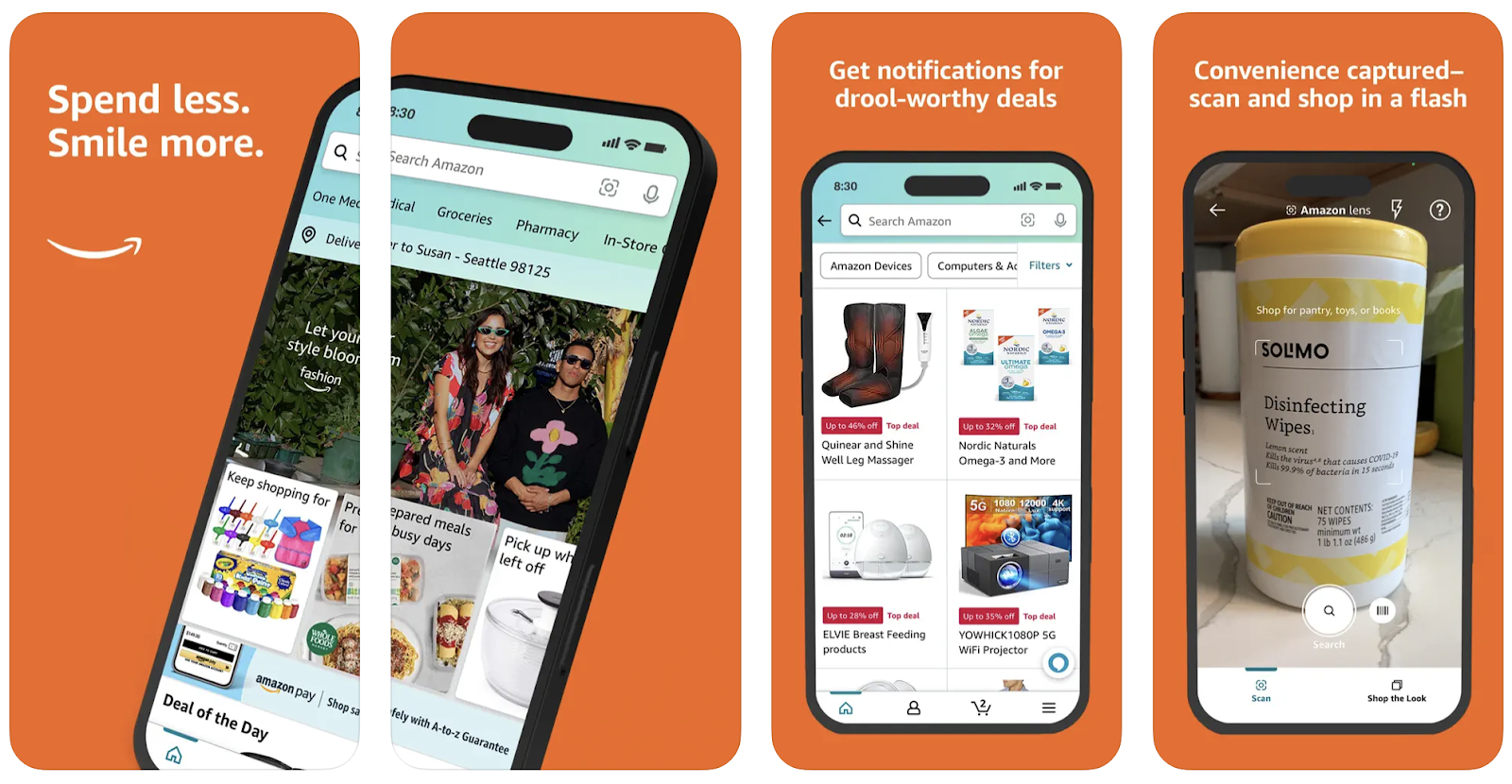
With 91% of online shoppers preferring to make purchases using their smartphones (according to Forbes Advisor), many companies are investing in mobile optimization for their websites and other platforms. Many retail companies are also investing in their own apps—like Amazon's app that even has exclusive offers—in order to capture this type of consumer and make the shopping experience even smoother.
Mobile-friendly designs, fast load times, and simplified checkout processes cater to the growing audience that shops exclusively on their handheld devices. Prioritizing this trend meets consumer expectations for convenience, enhancing the overall shopping experience and increasing conversion rates.
Livestream shopping

Initially gaining traction in countries like China through platforms like Alibaba, live shopping has become an ecommerce trend around the world, with platforms and social media integrating shopping functions via live streaming and even marketplaces fully dedicating themselves to the model, such as Poshmark.
It’s a sales model based on leveraging social proof, where a salesperson, influencer, or brand representative presents the product in live broadcasts, answering questions and interacting with the public. Creating a sense of urgency by encouraging viewers to make purchases during the event.
Livestream shopping is especially effective for fashion, beauty, and tech products, providing brands with a unique opportunity to showcase products in an engaging format.
Omnichannel shopping experience
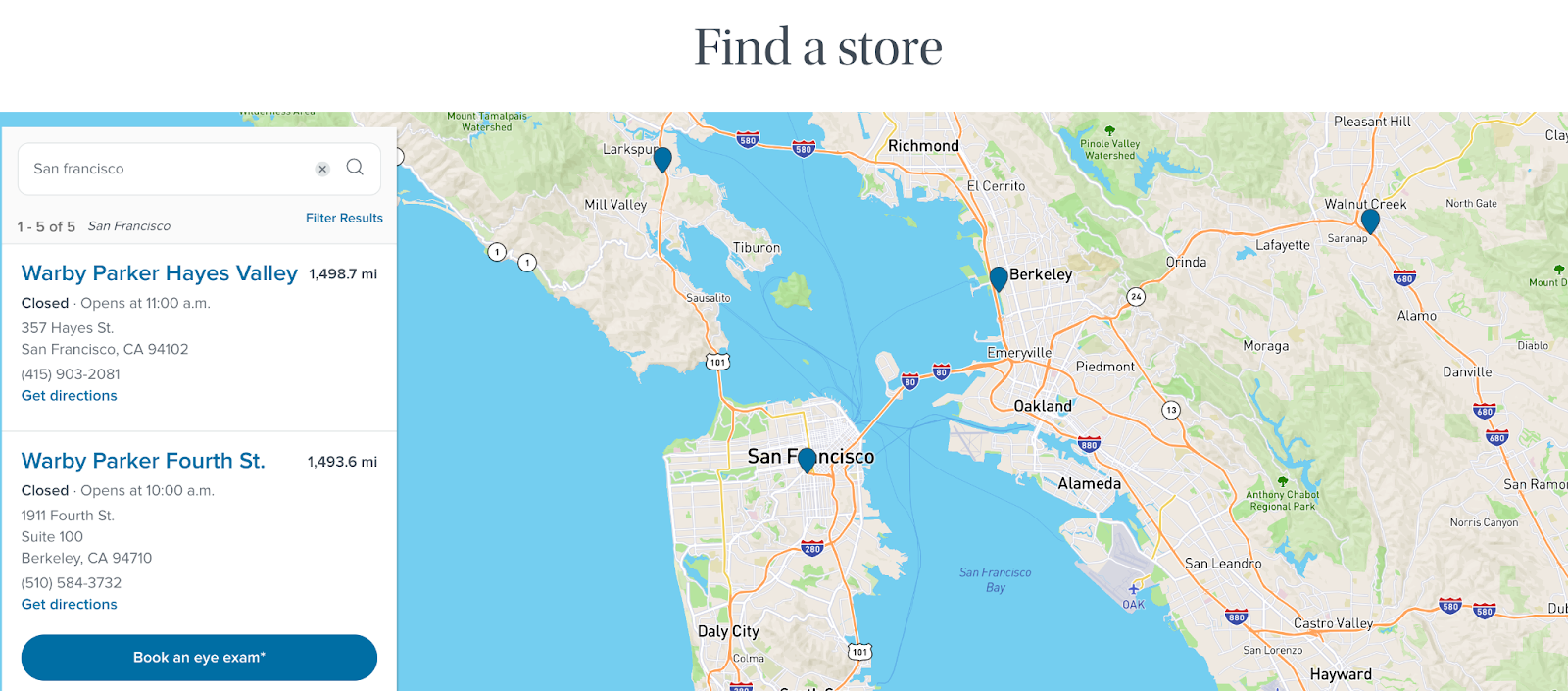
As we mentioned before, customer experience is a focal point of ecommerce trends. And with the internet allowing your business to operate across multiple platforms, it’s important that the user experience is the same regardless of which channel they’re using to check out your products and services.
For this reason, offering an omnichannel shopping experience is a growing trend among businesses, especially those focused on ecommerce.
Omnichannel integrates your company's sales and communication channels, such as physical stores, ecommerce, social networks, and mobile, among others, so that the customer can interact with the brand in a cohesive and personalized way. It places the user experience as the main focus, ensuring that retention and conversion rates are positive.
Focus on sustainability and ethical practices

Health, fitness, and eco-friendly products are a trend in themselves and several companies have invested heavily in natural products and sustainable practices, such as sustainable packaging, carbon-neutral shipping, and transparent sourcing to appeal to these values.
Following this trend is not only good from an economic point of view—after all, eco-conscious customers are willing to pay a premium for eco-friendly products—but it is also a genuinely positive practice for health and environmental preservation.
Multiple payment options

Offering a variety of payment options has become a regular in any sales platform, as ecommerce businesses are looking to cater to today’s diverse customer preferences. One standout choice is Buy Now, Pay Later (BNPL), which has gained traction among budget-conscious consumers who appreciate the flexibility to split payments over time, often without interest.
Beyond BNPL, options like cryptocurrency, digital wallets, and localized payment methods empower global and local shoppers alike, reducing friction at checkout. When customers see their preferred payment options available, cart abandonment rates drop, access widens, and conversion rates naturally improve.
Emphasis on faster shipping and delivery
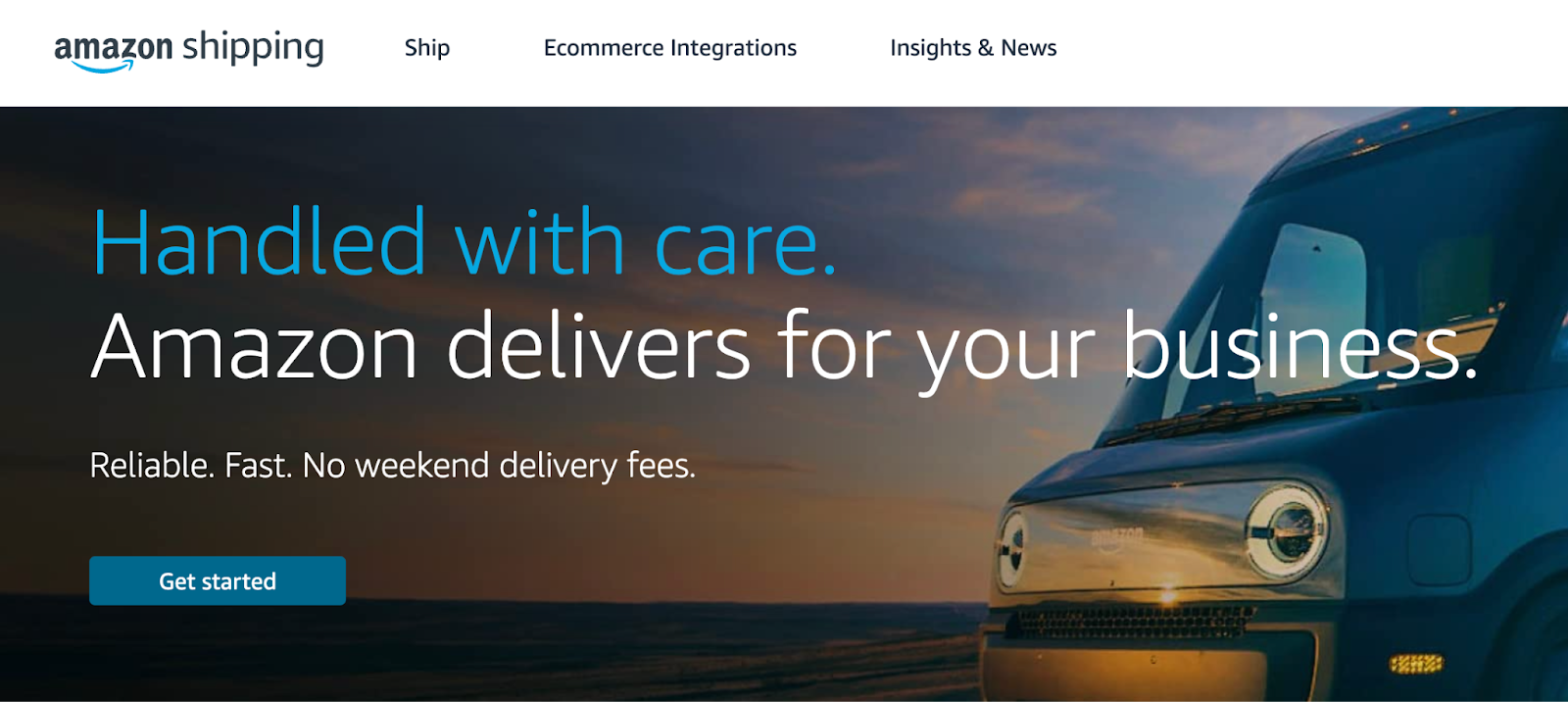
We mentioned earlier how shipping time is a big factor in a consumer's purchasing decision, and many companies have been investing heavily in reducing delivery times.
Amazon, for example, has fulfillment centers all over the world. Depending on the location, purchases made on Amazon’s marketplace arrive in a matter of days, even hours. The same goes for other platforms that offer a variety of delivery options to meet different needs.
When a store can reliably deliver what a shopper needs, quickly, that positive experience turns into repeat business. With fast shipping becoming a dealbreaker, embracing efficient delivery strategies isn’t just a trend—it’s a loyalty builder.
Data privacy
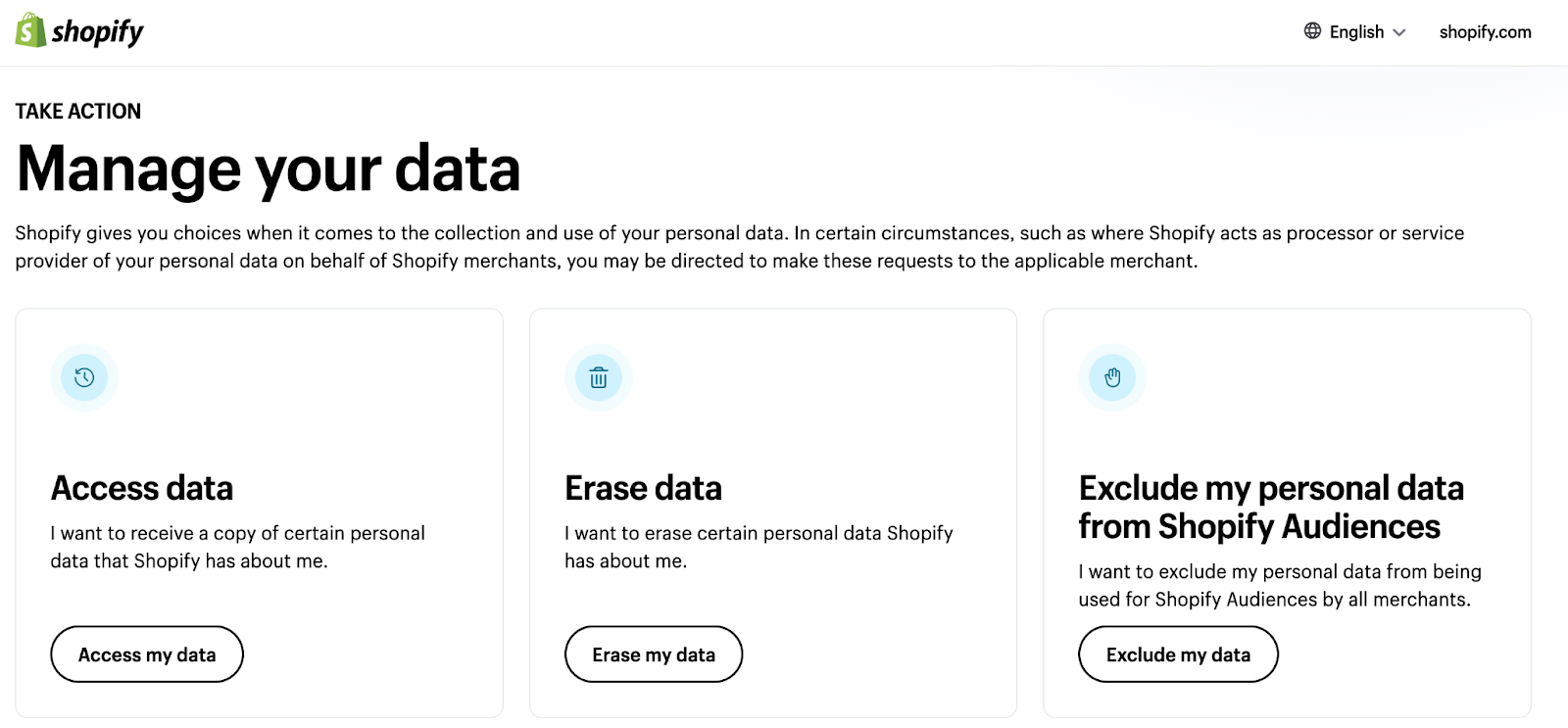
With online shopping, it’s normal for platforms to ask their users for personal information such as address, email, and phone number, among others. Shoppers want to know if this type of information is secure, and this push for transparency has ecommerce businesses implementing more stringent data privacy measures.
Compliance with regulations like the General Data Protection Regulation (GDPR), paired with a clear, user-friendly privacy policy, goes a long way in building trust. Beyond legal compliance, being upfront about data practices reassures customers, fostering confidence in the brand.
When customers feel secure, they’re not only more likely to make a purchase—they’re also more likely to return, creating a win-win situation for brands committed to respecting customer privacy.
Subscription-based online shopping
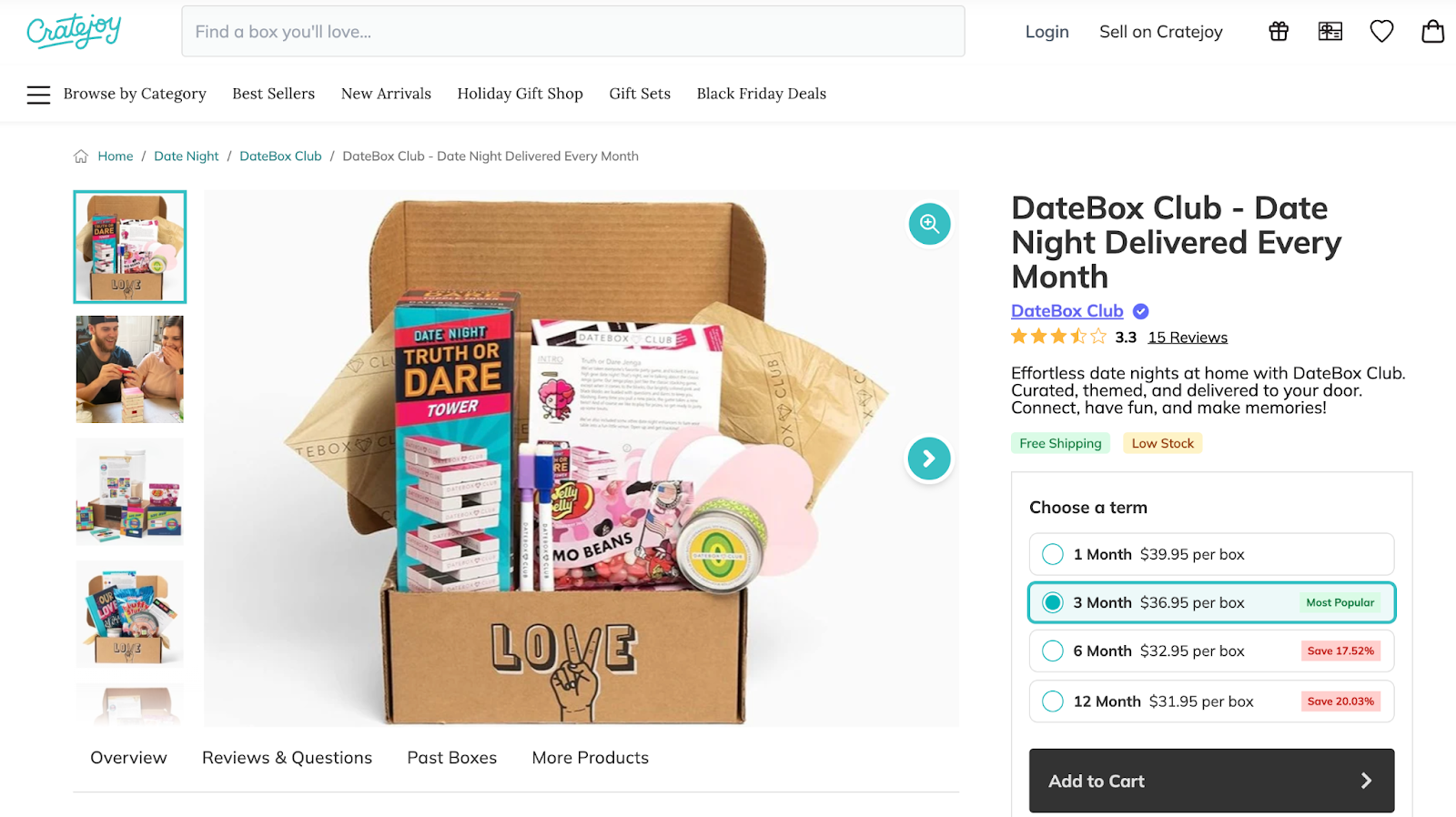
Subscription-based businesses have become quite popular in recent years, and a big sign of this is the constant ads for services like HelloFresh popping up left and right on YouTube and other platforms across the world.
This is a lasting ecommerce business model that caters to the “set it and forget it” mentality, perfect for products people need consistently—like healthy food, skincare, or even unique curated boxes of goodies.
But it can also be based on services, like access to unique platforms, online courses, or exclusive communities. For your business, a subscription-base model offers the huge advantage of a predictable revenue stream and the opportunity to build long-term relationships with customers
Want to learn everything ecommerce? Join a Whop community today
Staying up to date with the main ecommerce trends is important, and with Whop you can learn everything you need to implement these trends in the best possible way in your business.
There are hundreds of communities led by the biggest players in ecommerce, all ready to share their secrets and show you how to become a truly successful entrepreneur. Do you want to sell digital products? Set up a dropshipping operation? Or do you want to learn everything about trading so you can apply it yourself? Here you can access this and much more.
You only need a few minutes to start learning everything about ecommerce, join Whop today and pave your way to success.
Ecommerce trends in 2026 FAQs
The frequently asked questions about ecommerce trends.
Why is it essential to stay updated on ecommerce trends?
Keeping up with ecommerce trends helps businesses stay competitive, anticipate consumer expectations, and implement innovations that improve the shopping experience. Staying updated ensures a brand can adapt quickly and attract new customers while retaining existing ones.
Why should you trust us?
Joe Niehaus is an expert commerce content writer at Whop with years of expertise in branding, affiliate marketing, and content marketing for ecommerce. He has also contributed to renowned outlets such as Business Insider, GQ, and Travel + Leisure.


